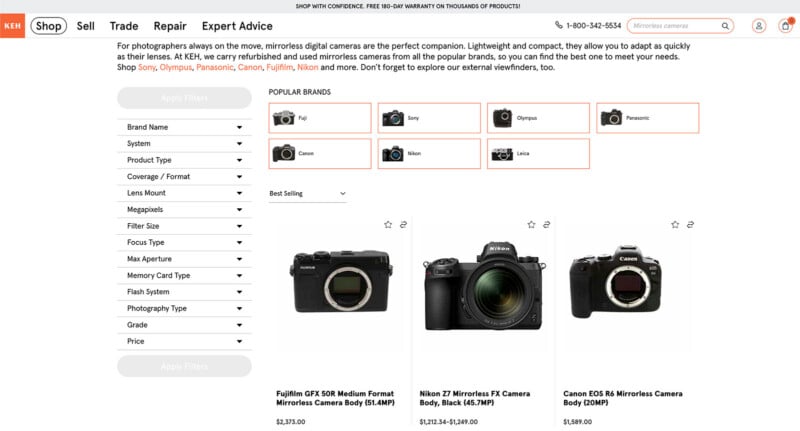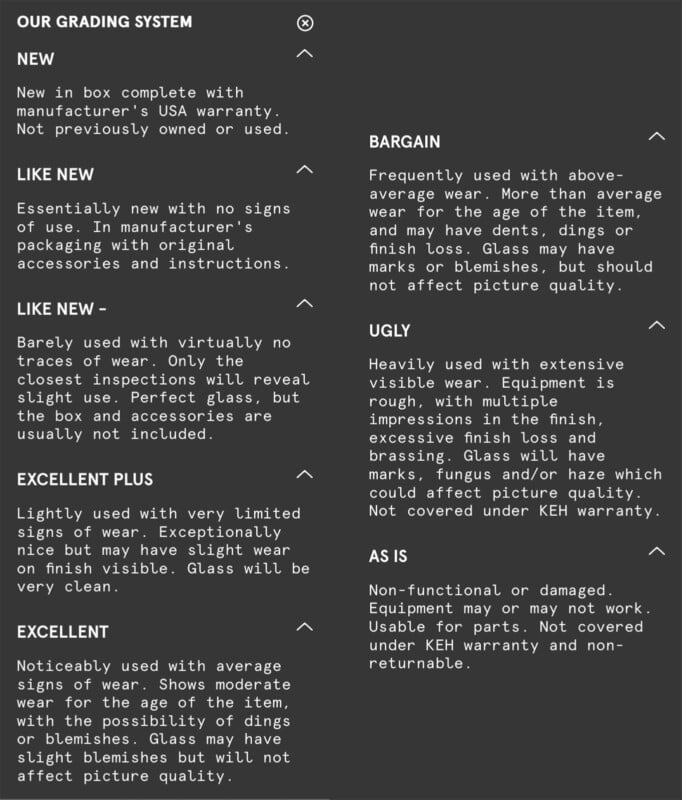
![]()
Ahead of Earth Day on April 22, 2024, KEH has announced a new marketing campaign to promote the buying and selling of pre-owned cameras and lenses — “Save the Planet. Buy Better Than New.”
The “Better Than New” slogan is designed to increase awareness and adoption of pre-owned cameras, lenses, and other photography gear. KEH hopes to incentivize photographers to consider their purchasing habits and realize the benefits of buying pre-owned instead of brand-new equipment.
“Since KEH’s inception more than 40 years, we’ve established our identity around the belief that pre-owned camera gear often has more ‘staying’ power in someone’s hands. Pre-owned gear sold and purchased with us, the experts in photo and video gear, is far superior to going to a typical retailer,” explains KEH’s CEO, Noah Treshnell. “We’re excited to launch our ‘Better Than New’ campaign, which further aligns with our vision, mission, and values of being the go-to resource for photographers to receive unparalleled gear and service.”
![]()
Three Reasons to Buy Pre-Owned Camera Gear
KEH touts three primary benefits of buying pre-owned from KEH, although the first two are generally valid for any retailer or individual offering pre-owned gear. Buying used gear is more affordable and better for the environment, and customers can trust the quality of the equipment when buying through KEH.
Buying used gear is better for photographers trying to save money. By buying pre-owned, it is possible to get the same thing for much less than buying new or even more equipment for the same price as a new camera or lens. Depending on the “grade” of the pre-owned gear, it’s possible to save up to 40% on equipment that functions like new, even if it doesn’t always look the part. Of course, for photographers who care about the appearance of their gear, plenty of pre-owned gear looks like it was just unboxed.
Photography is an expensive hobby; for many, buying new dream cameras and lenses is impossible. Used marketplaces help make photography more accessible and reduce the barrier to entry. The more options photographers have, and the more accessible photography is, the better.
Environmental Benefits
Beyond the financial benefits, buying and selling pre-owned gear has environmental advantages. By its very business model, KEH incorporates a circular approach to camera equipment. KEH gives photographers money for their used equipment; technicians clean, check, and repair the gear, if necessary; and other photographers then buy the pre-owned gear.
Treshnell tells PetaPixel that KEH takes in more than 1,000 pieces of gear daily, and nearly everything the company puts into its catalog is sold in a month or less. It is a constant cycling of camera equipment at the company’s Smyrna, Georgia headquarters. All of this pre-owned gear goes from photographer to KEH to a new photographer and never ends up in a landfill.

Even when a camera or lens arrives at KEH so damaged that it cannot be repaired, it is not discarded. KEH offers broken equipment “as is” to collectors and technicians seeking parts, and sometimes KEH itself “parts out” a camera, as the company also provides separate repair services. Treshnell says that its technicians have hundreds of years of experience repairing photo equipment.
“There are people on our tech team that have been doing this for 40-plus years each, and our tech team is well over 30-plus deep.”
While much of its clientele are typical photographers looking to either get money for old gear they don’t need or want anymore or people trying to save money, the company also serves a relatively small but very passionate group of camera collectors always looking for a new piece to add to their collection or an obscure part to help fix something they’ve already got.
Used Gear Makes Photography More Accessible
Treshnell tells PetaPixel that KEH is committed to the photography community, and part of that commitment is ensuring that photography is as accessible as possible.
“We focus on being inclusive, not exclusionary. Getting people into the gear they want and aspire to is a big part of what we’re about.”
“We had a training event, one of the guys brought in a few pieces of gear and he traded them in for one of the new Nikon Z mirrorless cameras,” Treshnell recalls. “This was his dream camera, and he had enough older gear to be able to afford it. We gave him a trade-in deal and he walked away with the camera of his dreams. It’s awesome to see that energy.”
Treshnell believes that because KEH makes photography equipment more affordable for people, the company attracts a relatively passionate customer. He also thinks the company operates differently from most other “for-profit” companies.
“Most for-profit companies, by definition, they’re gaining profit by extracting value out of the world. They’re taking more value out of the world than they’re giving back. That is their profit model. And then they’ll market these things that are givebacks but are small percentage relative to what they’re extracting,” Treshnell says.
“Well, that’s not our business model. Our business model is circular. By definition, we just need to do more of what we do. And as that gets bigger, the benefit to the planet, to the community, to the environment, it is a positive impact.”
For some, the benefit of buying from KEH is that they can afford the same equipment for less money than buying brand-new ones.

There are some tradeoffs, of course. Even though KEH’s library is huge, that doesn’t mean that a customer can find precisely what they’re looking for at any given time — although they probably can. Further, KEH has a 180-day warranty on its gear, which is nice, but not the three or five-year warranty that some camera companies offer with their equipment.
For others, reducing waste through their behavior is reason enough to shop for pre-owned gear.
And, of course, some photographers see KEH and other pre-owned equipment retailers as offering them a win-win: Save money and help the environment. Small, individual choices do eventually add up to a more considerable benefit.
KEH Wants to Change the Question From ‘Why Buy Used?’ to ‘Why Buy New?’
Treshnell emphasizes that while KEH’s “Better Than New” campaign is designed to help photographers think differently about pre-owned gear and their buying habits, ultimately, photographers must do what they feel is best for them. Maybe that means buying pre-owned, perhaps it doesn’t.
“You’re paying less to do good in the world and you’re getting more value for your money. That’s a pretty good deal,” Treshnell says.
“Once you’ve had those positive experiences [buying pre-owned equipment], it turns it around, and it becomes, ‘Why should I buy new?’ The more the world has that mentality of ‘Why buy new?’, the more we have a sustainable world.”
Image credits: KEH. Header photo licensed via Depositphotos






